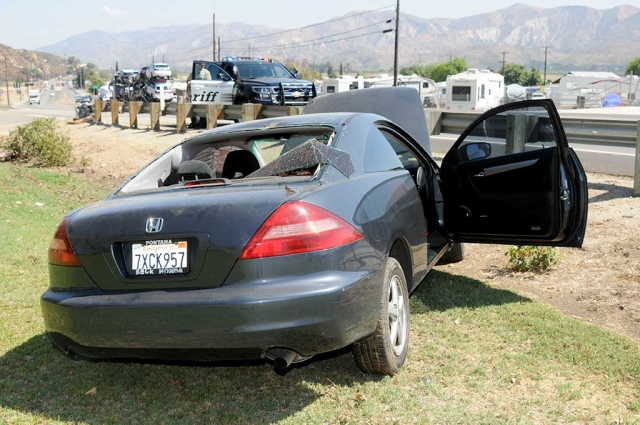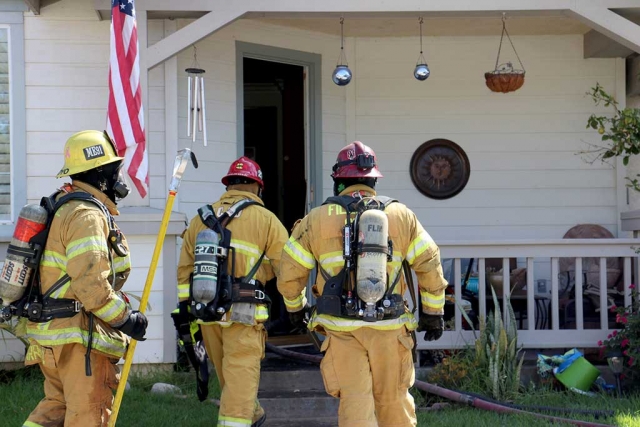|
By Anonymous — Wednesday, September 13th, 2017
The Santa Clara Valley Hospice is pleased to announce their new board director Ari Larson. One of Ari's goals, as a Fillmore resident is to better promote the resources available to the Fillmore and Piru community. In addition to Fillmore and Piru the Santa Clara Valley Hospice serves, Santa Paula, Somis and Saugus. "I look forward "For example, some of the lesser known resources available at SCV Hospice include medical equipment and supplies, available for loan and medical transport to doctor visits and medical therapists," said Ari. To find out more and to tour their facility, the public is invited to the Grand Re-Opening of their new location on Friday, Sept. 15th at 5pm at 217 N. 10th St. Santa Paula, CA 93060. If you have any questions please call their office 805.525.1333 or scvhospicehs@yahoo.com |
 Tuesday night’s City Council listened to the concerns of Fillmore citizens regarding Valley Express bus fare increases, and the ordinance on prohibiting trucks on River Street between A Street and Central. Enlarge Photo By Anonymous — Wednesday, September 13th, 2017
At Tuesday's regular City Council meeting, City Engineer Roxanne Hughes, presented a City Pavement Report to the Council, and Approval of Project List for RMRA Fund Eligibility. The City Council also approved a recommended project list and associated budget amendments to meet the funding eligibility guidelines for receipt of Road Maintenance and Rehabilitation Account (RMRA). Council approved unanimously. For complete details please refer to Council Agenda for 9-13, 2017. The Council appointed Council members Diane McCall and Mark Austin to the Fillmore Development Council (FDC) Ad Hoc Committee. During Public Comment, resident Bill Faith asked the Council to seek some solution to the problem of long-bed pickup trucks parking on Central Avenue. Trucks that extend beyond the designated parking length of spaces, and extend several feet into the traffic lanes pose a safety problem as well as a nuisance. The Council will look into the problem. A second reading of an ordinance prohibiting trucks on River Street between "A" Street and Central Avenue to limit truck traffic and request to post traffic signs noting this prohibition was observed. A discussion of Draft August 2017 Valley Express Fare Increases was made. Martin Erickson of VCTC gave a presentation on the new rate proposals. A history of Valley Express, launched March 2, 2015 was noted, as was a new local fixed route service, and a new fleet of 15 busses. During the past year Valley Express held public meetings approving the expansion of general public Dial-A-Ride to the entire Heritage Valley area. Also discussed was potential fare increases. The Committees approved expanding the General Public Dial-A-Ride to be available to all riders in the Heritage Valley service area, not just to seniors or just those with disabilities. All riders in the Valley Express service area are now able to request door-to-door bus service. The price is $2.00 per trip. For complete information on Valley Express schedules and prices please consult www.valleyexpressbus.org. City Manager David Rowlands reported that a resolution of the contractual problems between the FCTC and Fillmore & Western Railroad has been reached. The Railroad will continue to operate as usual under the new settlement. |
|
By Anonymous — Wednesday, September 13th, 2017
District Attorney Gregory D. Totten announced today that many county residents have likely been affected by the Equifax data breach and advises that they consider appropriate steps to protect their personal data. Equifax is one of three major credit reporting agencies. According to Equifax, from mid-May through July 2017, they suffered a data breach that affected the personal identifying information of 143 million Americans and 15 million Californians. Be aware that Equifax representatives will not call residents unless the residents first call Equifax. Unsolicited calls could be a scam. Consumers may contact Equifax to learn whether their data was potentially exposed. Contact may be made in one of two ways: According to the Equifax website, even if one’s data was not exposed, Equifax will enroll consumers in the TrustedID Premier service if requested by November 21, 2017. This provides, free of charge: - Social security number monitoring. Equifax will search for suspicious websites for the consumer’s social security number. - Identity theft insurance of up to $1,000,000. - Equifax Credit Report lock. This prevents access to the consumer’s Equifax credit report by third parties, with certain exceptions. This acts as a “red flag” to credit issuers and is designed to lead to the consumer being notified before the lock is lifted. However, this only applies to Equifax reports. Consumers are encouraged to contact the other two major credit reporting agencies to place a red flag (free) or a lock (up to $35). The contact information is: - TransUnion 1-800-680-7289 / www.transunion.com/fraud All consumers that sign up for TrustedID Premier will be asked for the last six numbers of their social security number and will be issued a randomly generated PIN number. They will not be asked to provide credit card information nor will they be charged after the year of Trusted ID Premier has expired. Equifax has also changed its policy and those that take advantage of Equifax’s offer will not waive any rights to take legal action against Equifax. For more information on the Equifax breach go to: To check your credit reports for free visit: For more information on what to do as a result of a breach and to avoid identity theft go to: |
|
By Anonymous — Wednesday, September 13th, 2017
 On Tuesday, September 12th at 1:44pm a Honda slammed into the stop sign and guardrail near Ventura and Santa Clara Street and rolled. No injuries were reported for the driver, there were no passengers. Cause of the accident is under investigation. Enlarge Photo |
|
By Anonymous — Wednesday, September 13th, 2017
 Fillmore, Ventura County and Santa Paula Fire Departments responded to a structure fire in the 900 block of Aerosmith Lane in Fillmore. Upon arrival crews found smoke coming from what seemed like the attic. Upon entry the first crew found smoke coming from the master bedroom and a lamp and bedroom content on fire. Cause of fire is under investigation. Crews were on scene for about 40 minutes. Photos courtesy Fillmore Fire Department. Enlarge Photo |
 Photo of the week is "Fire Department 9/11 flag over Landeros Lane" by Bob Crum. Photo details: ISO 100, 22mm, f/5.0 @1/60second. Enlarge Photo By Bob Crum — Wednesday, September 13th, 2017
Secret sauce revealed!
I'm overwhelmed with so many readers' questions that I'm contemplating taking a three month vacation in Hawaii. Between Maui, O'ahu, Kaua'i, Moloka'i and The Big Island there are at least 23 mermaids at last count. Paradise! But I digress. Again, the most asked question lately is about photo editing, aka post processing. Though challenging, it's an important question because as I'm want to say: No photo straight out of the camera is as good as it can be. Relax. Photo editing might seem daunting because it's not quite zippity-doo-dah easy. But I'm not going to get technically wonky. If you can drive a car... you can learn how to create awesome photos with some editing knowledge and the appropriate computer programs. Ever since I (reluctantly) went digital , I capture images in the RAW format. RAW is a file format that includes all the image data from the camera sensor unprocessed by the camera. While RAW provides for greater editing flexibility in a non-destructive way, I have to start with RAW photos because the majority of my clients require high resolution photos. My Canon 7D MKII produces 300ppi (pixels per inch) RAW images. After editing, I adjust the resolution to meet client's requirements. Jpegs are processed and compressed by the camera's computer. In the compression process, the camera throws away a big chunk of the photo pixels. Ouch! Camera companies claim that their camera is optimized to produce lovely looking jpeg images. Really? Try this: A skunk (a camera) is a beautiful black and white animal whose byproduct (jpegs) is odorous... and not in a good way. I dramatize! Don't misunderstand me. While jpegs are compromised images, I don't mean to imply that all jpegs stink. They don't! A fairly good camera can produce very good jpeg images. My 7DMark II produces very nice jpegs. Some cameras only produce jpegs... RAW not an option. There are some advantages to shooting jpegs. Jpegs are less stressful. For snapshots of Johnny's BD party, or Dirk and Susie's anniversary, or snapshots of a turtle race, jpegs are the cat's meow. No editing... shoot and immediately share on social media. For the creative urge in you, many cameras provide jpeg “picture style” options. Oh joy! Learn them and apply when appropriate. BTW, the images I submit for publication were RAW converted to jpegs, albeit high resolution jpegs. There you go! However what if you crave something a little better (you know you do)? Hello photo editing. Of course the granddaddy is Photoshop. It's powerful. So powerful it scares me. For the frugal among you, there are free photo editing programs. Gimp is the most popular. Many say that Gimp is an exceptional photo editor, rivaling premium software. Never used it so can't vouch for the hype. Other free programs include Paint.net, Photo Pos Pro and Photoscape among others. Google them for details. Which one to choose? Depends on your requirements. Different tasks require different tools. Check the websites, reviews, and decide. Check youtube for tutorials on the various programs. Photoshop Elements is good but better with NIK plugins (secret sauce) installed. They're free from Google. I use Color Efex Pro 4 and Viveza 2. Caution: Google quit supporting NIK plugins. Ugh! Thus, not guaranteed to work in an Elements version higher than 12. I am still using Elements 11 on Windows 7 Pro because it works! Version 11 is cheap on eBay! Once you learn and use NIK you'll be a photo editing genius. Photo editing is not without a learning curve but well worth the time and effort if you have any interest in producing the best photos possible. Just sayin'. Happy photoing. Send comments, suggestions or questions to bob@fillmoregazette.com |
|
By Mark Ortega — Wednesday, September 13th, 2017
Food, Family, Fun, and a Parade!
Who puts tables and chairs on Central Avenue and asks the community of Fillmore to come out and break bread with their Neighbors? The FHS Alumni Association does, that's who. On Thursday evening September 21st from 5-9pm, the FHS Alumni Association will close down Central Avenue between Sespe Avenue and Main Street to celebrate Homecoming 2017. We ask all Alumni and the community to come out early and eat downtown. There will be plenty of tables and chairs and different food vendors to choose from. There will be a DJ (Danny Ibarra 'FHS '85) playing in front of Central Station, and a live Band (Richard Carrillo, Class of '75) will have his "Country Roads" band near Main Street playing all your favorites, old and new for everyone to enjoy. Once you get your meal and a place to sit, sit back, relax, and watch Fillmore High's Homecoming Parade 2017. The parade starts promptly at 6:30pm from the corner of 2nd and Central. The parade will continue down Central Avenue and end at Main Street. Right after the parade, the high school will crown the Homecoming King and Queen on a stage under the Town Theater marquee. So much fun in Fillmore next Thursday evening. Calling all Alumni from around the county and the community of Fillmore to come out for Food, Family, and Fun in Beautiful Downtown Fillmore. Go Flashes!! |
|
By Anonymous — Wednesday, September 13th, 2017
Jose “Froggy” Estrada is back and ready for the Combate Americas “El Grito en la Jaula” (Translation: Americas Battle Cry of the Cage). On Friday September 15th in Redlands California he will take on Izic Fernandez who has a 2–3 record. Froggy looks to advance his record to 4-1, as he makes his debuted in the Featherweight class (145lbs) with this fight. The fight will be at Splash Kingdom Amphitheater in Redlands California. Doors open at 5pm. You can tune in on Azteca TV, ESPN Deportes or ESPN. Tickets can be purchased at www.tickton.com |
|
By Anonymous — Monday, September 11th, 2017
The event will celebrate peace makers in our community and a special dedication to the memory of local favorite Janine Rees
INTERNATIONAL DAY OF PEACE ON SEPTEMBER 21: Soroptimists will once again host the celebration of the International Day of Peace on September 21 at 6:00p.m. at the Peace Pole in City Park. The event will celebrate peace makers in our community and a special dedication to Janine Rees. Come to help us remember that peace starts with each of us! For information, contact Lynn Edmonds 907-6576. |
|
By Anonymous — Monday, September 11th, 2017
New “Let’s Talk Cannabis” Web Page
Today, the California Department of Public Health (CDPH) launched a health information and education campaign about what’s legal in California and potential health impacts of cannabis use. Senate Bill 94 (SB 94) - Medicinal and Adult Use Cannabis Regulation and Safety Act (MAUCRSA) - makes it legal for adults 21 or older to possess, consume and cultivate cannabis in California. Sale of cannabis from licensed retail outlets will become legal January 1, 2018. CDPH received funding to develop a campaign, as detailed in SB 94, describing: “CDPH engaged in extensive conversations with stakeholders in California and partners in other states with legalized cannabis to target the most vulnerable populations and apply their lessons learned,” said CDPH Director and State Public Health Officer Dr. Karen Smith. “We are committed to providing Californians with science-based information to ensure safe and informed choices.” CDPH has and will continue to incorporate the latest data available into public messages to increase awareness about how cannabis affects bodies, minds and health. On CDPH’s website, individuals can find information about legal, safe and responsible use, and health information for youth, pregnant and breastfeeding women, parents and mentors, and health care providers. CDPH produced fact sheets with safe storage tips and the important things Californians need to know about purchasing and possessing cannabis for personal use. An educational digital toolkit for local governments and community organizations will be available in the future. For additional information, visit the Let’s Talk Cannabis web page at https://www.cdph.ca.gov/Programs/DO/letstalkcannabis/Pages/LetsTalkCanna... |














